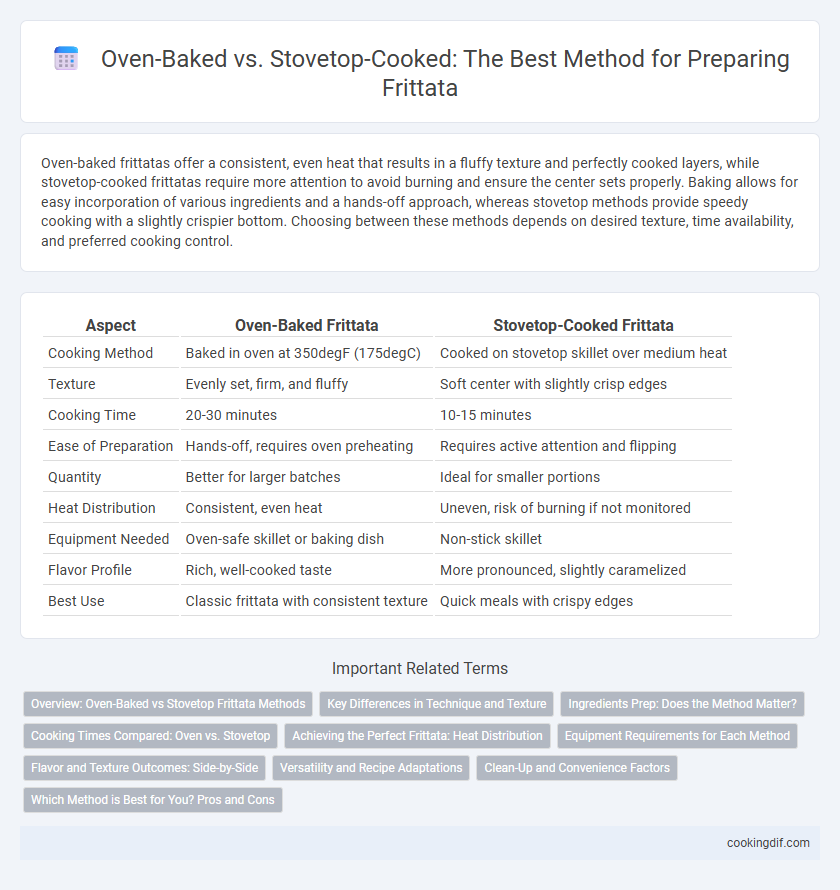Oven-baked frittatas offer a consistent, even heat that results in a fluffy texture and perfectly cooked layers, while stovetop-cooked frittatas require more attention to avoid burning and ensure the center sets properly. Baking allows for easy incorporation of various ingredients and a hands-off approach, whereas stovetop methods provide speedy cooking with a slightly crispier bottom. Choosing between these methods depends on desired texture, time availability, and preferred cooking control.
Table of Comparison
| Aspect | Oven-Baked Frittata | Stovetop-Cooked Frittata |
|---|---|---|
| Cooking Method | Baked in oven at 350degF (175degC) | Cooked on stovetop skillet over medium heat |
| Texture | Evenly set, firm, and fluffy | Soft center with slightly crisp edges |
| Cooking Time | 20-30 minutes | 10-15 minutes |
| Ease of Preparation | Hands-off, requires oven preheating | Requires active attention and flipping |
| Quantity | Better for larger batches | Ideal for smaller portions |
| Heat Distribution | Consistent, even heat | Uneven, risk of burning if not monitored |
| Equipment Needed | Oven-safe skillet or baking dish | Non-stick skillet |
| Flavor Profile | Rich, well-cooked taste | More pronounced, slightly caramelized |
| Best Use | Classic frittata with consistent texture | Quick meals with crispy edges |
Overview: Oven-Baked vs Stovetop Frittata Methods
Oven-baked frittatas offer an even, slow cooking process that allows eggs to set uniformly while creating a light, fluffy texture and a golden-brown top crust. Stovetop frittatas cook faster with direct heat, often resulting in a thicker, denser consistency and requiring careful heat management to avoid burning or undercooking the center. Both methods emphasize different textures and cooking times, with ovens providing consistent heat distribution and stovetop enabling quick, hands-on control.
Key Differences in Technique and Texture
Oven-baked frittatas cook evenly through gentle radiant heat, resulting in a uniformly set, fluffy texture with a lightly browned top, ideal for thicker mixtures and large portions. Stovetop-cooked frittatas rely on direct heat from the pan, producing a denser, slightly crustier base with a moist interior, and require careful temperature control to avoid burning or undercooking. The oven method offers hands-off cooking with consistent results, while stovetop preparation demands active attention and frequent flipping or broiling to achieve desired doneness.
Ingredients Prep: Does the Method Matter?
Oven-baked frittatas require evenly chopped ingredients to ensure consistent cooking throughout the dish, as the heat surrounds the pan uniformly. Stovetop-cooked frittatas demand more precise sauteing of vegetables and proteins beforehand to achieve the desired texture and prevent uneven cooking. Proper ingredient preparation adapts to each method, influencing the final flavor and consistency of the frittata.
Cooking Times Compared: Oven vs. Stovetop
Oven-baked frittatas typically require 15-20 minutes at 350degF (175degC) to cook through evenly, allowing for a consistent texture and thorough heat distribution. Stovetop-cooked frittatas usually take 10-15 minutes over medium-low heat, but require careful monitoring to prevent uneven cooking and potential burning. Choosing between methods depends on desired cooking time and texture preferences, with oven baking offering more hands-off cooking and stovetop providing quicker results.
Achieving the Perfect Frittata: Heat Distribution
Oven-baked frittatas benefit from even heat distribution, allowing the eggs to cook uniformly and the top to set without browning too quickly. Stovetop-cooked frittatas require careful control of temperature to avoid uneven cooking, often needing a lid to trap heat and cook the center thoroughly. Utilizing an oven ensures consistent heat envelops the dish, producing a tender, well-cooked frittata with a creamy texture throughout.
Equipment Requirements for Each Method
Oven-baked frittatas require a preheated oven and an oven-safe skillet or baking dish, ensuring even heat distribution and a uniform cook. Stovetop-cooked frittatas need a non-stick or cast-iron skillet with a tight-fitting lid for controlled heat and moisture retention. Oven baking offers hands-off cooking, while stovetop methods demand attentive temperature management and frequent monitoring to prevent burning.
Flavor and Texture Outcomes: Side-by-Side
Oven-baked frittatas develop a uniformly set texture with a golden, slightly crispy top and a tender, fluffy interior, enhancing flavor depth through even heat distribution. Stovetop-cooked frittatas yield a softer, creamier base with a lightly browned bottom, allowing for quicker cooking and a more delicate, custard-like texture. Flavor intensity in oven-baked versions benefits from gradual caramelization, while stovetop methods preserve fresh ingredient notes with less browning.
Versatility and Recipe Adaptations
Oven-baked frittatas offer consistent, even cooking, allowing for easy inclusion of a wide variety of ingredients such as vegetables, cheeses, and meats, making them highly versatile for diverse recipes. Stovetop-cooked frittatas enable faster preparation and greater control over browning and texture but may require more attention to prevent sticking or uneven cooking. Both methods adapt well to personalized seasoning and ingredient combinations, but the oven method supports larger, thicker frittatas best suited for serving multiple portions.
Clean-Up and Convenience Factors
Oven-baked frittatas offer uniform cooking and minimal active attention, requiring only a single baking dish that simplifies clean-up. Stovetop-cooked frittatas demand constant monitoring and flipping, often using multiple pans that can increase post-meal washing time. For convenience, oven-baking suits batch preparation while stovetop methods provide quicker, smaller servings but with more intensive clean-up.
Which Method is Best for You? Pros and Cons
Oven-baked frittatas offer even cooking and a fluffy texture, making them ideal for serving larger groups and allowing hands-free preparation, but they require longer cooking times and preheating. Stovetop-cooked frittatas provide quicker results with more control over browning and texture, suited for smaller portions and immediate consumption, though they demand constant attention to prevent burning or uneven cooking. Choosing between these methods depends on your time availability, portion size, and preference for texture and convenience.
Oven-baked vs Stovetop-cooked for frittata preparation Infographic

 cookingdif.com
cookingdif.com